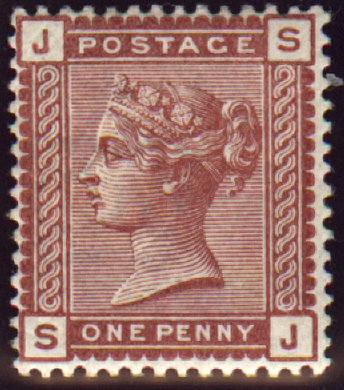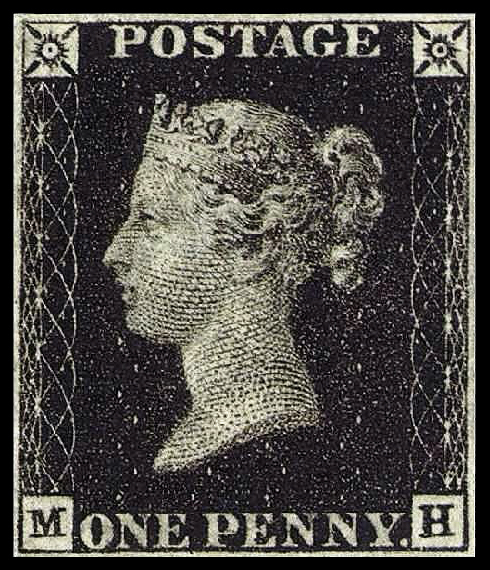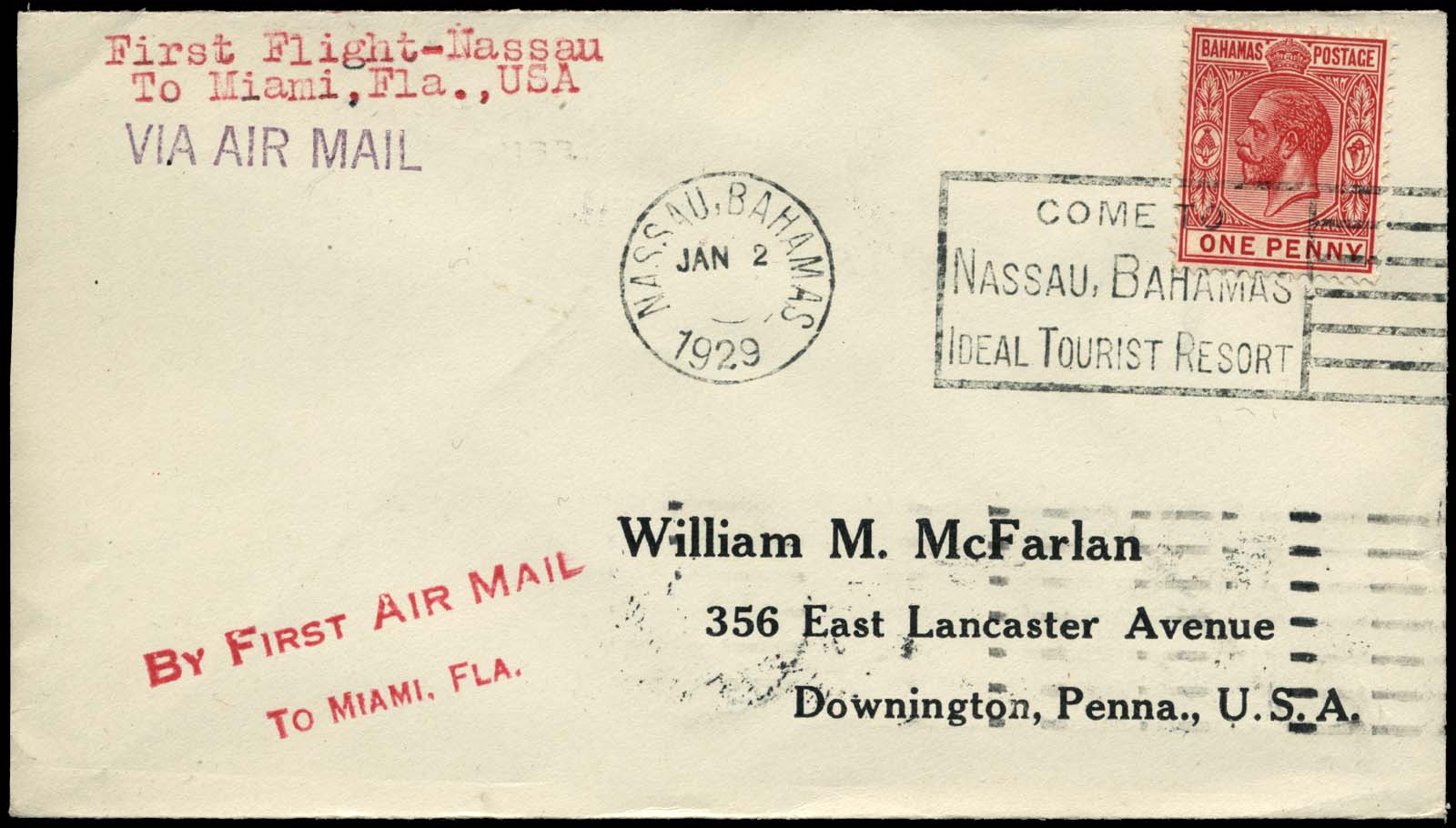|
Penny Venetian Red
The Penny Venetian Red was a British postage stamp equal to the value of one penny. Issued in 1880, it was designed and surface-printed by security printing company De La Rue. It superseded the Penny Red that had been used in Great Britain since 1841, and was the third one-penny stamp to enter regular usage in the country. The Venetian Red was aesthetically similar to the Penny Red and Penny Black that had come before it, but was instead coloured a venetian red and had a square framing. Close to 1.5 million Venetian Reds were printed during the stamp's run; the printing plates used allowed for 240 stamps each. Like its predecessors, the Venetian Red sported individual letters in each of its corners to identify its position on the plate. : The Venetian Red had a short run, and was replaced by the Penny Lilac in July 1881. Its displacement is attributed to a change in government postal policy: the Customs and Inland Revenue Act 1881 necessitated the creation of a new provi ... [...More Info...] [...Related Items...] OR: [Wikipedia] [Google] [Baidu] |
Venetian Red
Venetian red is a light and warm (somewhat unsaturated) pigment that is a darker shade of red, derived from nearly pure ferric oxide (Fe2O3) of the hematite type. Modern versions are frequently made with synthetic red iron oxide. Historically, Venetian red was a red earth color often used in Italian Renaissance paintings. It was also called sinopia because the best-quality pigment came from the port of Sinop in northern Turkey. It was the major ingredient in the pigment called ', described by the 15th-century Italian painter and writer Cennino Cennini in his handbook on painting, ''Il libro dell'arte''. Cennini recommended mixing Venetian red with lime white, in proportions of two to one, to paint the skin tones of faces, hands and nudes. During the English Civil War (1642–1651), Venetian red was adopted as the primary uniform colour of the New Model Army, to ease mutual identification on the battlefield. In addition, Venetian red was cheaper than other dyes at the time. Fo ... [...More Info...] [...Related Items...] OR: [Wikipedia] [Google] [Baidu] |
Postage Stamps And Postal History Of Great Britain
Postage stamps and postal history of Great Britain surveys postal history from the United Kingdom and the postage stamps issued by that country and its various historical territories until the present day. The postal history of the United Kingdom is notable in at least two respects: first, for the introduction of postage stamps in 1840, and secondly for the establishment of an efficient postal system throughout the British Empire, laying the foundation of many national systems still in existence today. As the originator of postage stamps, the UK is the only country that does not need to specify the country on its stamps, but only the denomination. Until 2022 any postage stamps since the 1971 decimalisation of British currency could be used; old "definitive" design stamps without barcodes are no longer valid from 1 February 2023, with old ones exchangeable for barcoded ones indefinitely. Special Stamps with pictures and Christmas Stamps without a barcode remain valid. Images o ... [...More Info...] [...Related Items...] OR: [Wikipedia] [Google] [Baidu] |
Cancellation (mail)
A cancellation (or cancel for short; French: ) is a postal marking applied on a postage stamp or postal stationery to deface the stamp and to prevent its reuse. Cancellations come in a huge variety of designs, shapes, sizes, and colors. Modern cancellations commonly include the date and post office location where the stamps were mailed, in addition to lines or bars designed to cover the stamp itself. The term " postmark" refers specifically to the part that contains the date and posting location, but the term is often used interchangeably with "cancellation" as it may serve that purpose. The portion of a cancellation that is designed to deface the stamp and does not contain writing is also called the "obliteration" Scott US p. 30A. or killer. Some stamps are issued pre-cancelled with a printed or stamped cancellation and do not need to have a cancellation added. Cancellations can affect the value of stamps to collectors, positively or negatively. Cancellations of some countrie ... [...More Info...] [...Related Items...] OR: [Wikipedia] [Google] [Baidu] |
Fugitive Pigments
Fugitive pigments are impermanent pigments that lighten, darken, or otherwise change in appearance or physicality over time when exposed to environmental conditions, such as light, temperature, humidity, or pollution. Fugitive pigments are present in types of paint, markers, inks etc., which are used for temporary applications. Fugitive inks which washed away when soaked in water were sometimes used deliberately to prevent postage stamps being removed from envelopes by soaking, and reused (e.g., the Queen Victoria Lilac and Green Issue). While permanent pigments are usually used for painting Painting is the practice of applying paint, pigment, color or other medium to a solid surface (called the "matrix" or "support"). The medium is commonly applied to the base with a brush, but other implements, such as knives, sponges, and a ...s, painters have made work wholly or partially with fugitive pigments for a number of reasons: availability and cost of pigments; being more ... [...More Info...] [...Related Items...] OR: [Wikipedia] [Google] [Baidu] |
Revenue Stamp
A revenue stamp, tax stamp, duty stamp or fiscal stamp is a (usually) adhesive label used to designate collected taxes or fees on documents, tobacco, alcoholic drinks, drugs and medicines, playing cards, hunting licenses, firearm registration, and many other things. Typically, businesses purchase the stamps from the government (thereby paying the tax), and attach them to taxed items as part of putting the items on sale, or in the case of documents, as part of filling out the form. Revenue stamps often look very similar to postage stamps, and in some countries and time periods it has been possible to use postage stamps for revenue purposes, and vice versa. Some countries also issued dual-purpose postage and revenue stamps. Description Revenue stamps are stamps used to designate collected taxes and fees. They are issued by governments, national and local, and by official bodies of various kinds. They take many forms and may be gummed and ungummed, perforated or imperforat ... [...More Info...] [...Related Items...] OR: [Wikipedia] [Google] [Baidu] |
Customs And Inland Revenue Act 1881
Customs is an authority or agency in a country responsible for collecting tariffs and for controlling the flow of goods, including animals, transports, personal effects, and hazardous items, into and out of a country. Traditionally, customs has been considered as the fiscal subject that charges customs duties (i.e. tariffs) and other taxes on import and export. In recent decades, the views on the functions of customs have considerably expanded and now covers three basic issues: taxation, security, and trade facilitation. Each country has its own laws and regulations for the import and export of goods into and out of a country, enforced by their respective customs authorities; the import/export of some goods may be restricted or forbidden entirely. A wide range of penalties are faced by those who break these laws. Overview Taxation The traditional function of customs has been the assessment and collection of customs duties, which is a tariff or tax on the importation or, ... [...More Info...] [...Related Items...] OR: [Wikipedia] [Google] [Baidu] |
Penny Lilac
A penny is a coin ( pennies) or a unit of currency (pl. pence) in various countries. Borrowed from the Carolingian denarius (hence its former abbreviation d.), it is usually the smallest denomination within a currency system. Presently, it is the formal name of the British penny ( p) and the ''de facto'' name of the American one-cent coin (abbr. ¢) as well as the informal Irish designation of the 1 cent euro coin (abbr. c). It is the informal name of the cent unit of account in Canada, although one-cent coins are no longer minted there. The name is used in reference to various historical currencies, also derived from the Carolingian system, such as the French denier and the German pfennig. It may also be informally used to refer to any similar smallest-denomination coin, such as the euro cent or Chinese fen. The Carolingian penny was originally a 0.940-fine silver coin, weighing pound. It was adopted by Offa of Mercia and other English kings and remained ... [...More Info...] [...Related Items...] OR: [Wikipedia] [Google] [Baidu] |
Penny Black
The Penny Black was the world's first adhesive postage stamp used in a public postal system. It was first issued in the United Kingdom (referred to in philatelic circles as Great Britain), on 1 May 1840, but was not valid for use until 6 May. The stamp features a profile of Queen Victoria. In 1837, British postal rates were high, complex and anomalous. To simplify matters, Sir Rowland Hill proposed an adhesive stamp to indicate pre-payment of postage. At the time it was normal for the recipient to pay postage on delivery, charged by the sheet and on distance travelled. By contrast, the Penny Black allowed letters of up to to be delivered at a flat rate of one penny, regardless of distance. Treasury competition On 13 February 1837, Sir Rowland Hill proposed to a government enquiry both the idea of a pre-paid stamp and a pre-paid envelope, a separate sheet folded to form an enclosure for carrying letters. Hill was given a two-year contract to run the new system, and toge ... [...More Info...] [...Related Items...] OR: [Wikipedia] [Google] [Baidu] |
United Kingdom
The United Kingdom of Great Britain and Northern Ireland, commonly known as the United Kingdom (UK) or Britain, is a country in Europe, off the north-western coast of the European mainland, continental mainland. It comprises England, Scotland, Wales and Northern Ireland. The United Kingdom includes the island of Great Britain, the north-eastern part of the island of Ireland, and many List of islands of the United Kingdom, smaller islands within the British Isles. Northern Ireland shares Republic of Ireland–United Kingdom border, a land border with the Republic of Ireland; otherwise, the United Kingdom is surrounded by the Atlantic Ocean, the North Sea, the English Channel, the Celtic Sea and the Irish Sea. The total area of the United Kingdom is , with an estimated 2020 population of more than 67 million people. The United Kingdom has evolved from a series of annexations, unions and separations of constituent countries over several hundred years. The Treaty of Union between ... [...More Info...] [...Related Items...] OR: [Wikipedia] [Google] [Baidu] |
Great Britain
Great Britain is an island in the North Atlantic Ocean off the northwest coast of continental Europe. With an area of , it is the largest of the British Isles, the largest European island and the ninth-largest island in the world. It is dominated by a maritime climate with narrow temperature differences between seasons. The 60% smaller island of Ireland is to the west—these islands, along with over 1,000 smaller surrounding islands and named substantial rocks, form the British Isles archipelago. Connected to mainland Europe until 9,000 years ago by a landbridge now known as Doggerland, Great Britain has been inhabited by modern humans for around 30,000 years. In 2011, it had a population of about , making it the world's third-most-populous island after Java in Indonesia and Honshu in Japan. The term "Great Britain" is often used to refer to England, Scotland and Wales, including their component adjoining islands. Great Britain and Northern Ireland now cons ... [...More Info...] [...Related Items...] OR: [Wikipedia] [Google] [Baidu] |
Penny Red
The Penny Red was a British postage stamp, issued in 1841. It succeeded the Penny Black and continued as the main type of postage stamp in the United Kingdom of Great Britain and Ireland until 1879, with only minor changes to the design during that time. The colour was changed from black to red because of difficulty in seeing a cancellation mark on the Penny Black; a black cancellation mark was readily visible on a Penny Red. History Initially, the same plates used to print the Penny Black were used to print the Penny Red. About 21 billion Penny Reds were printed by Messrs. Perkins, Bacon & Co. The stamp had no perforations, and had to be cut from the sheet using scissors in the same manner as for the Penny Black and the early printings of the Two pence blue. Perforations (experimental gauge 16) first came into use in 1850 and were officially adopted in 1854 (in the same size as the experimental issue). The experimental perforated issue can be distinguished from the gene ... [...More Info...] [...Related Items...] OR: [Wikipedia] [Google] [Baidu] |





.jpg)


